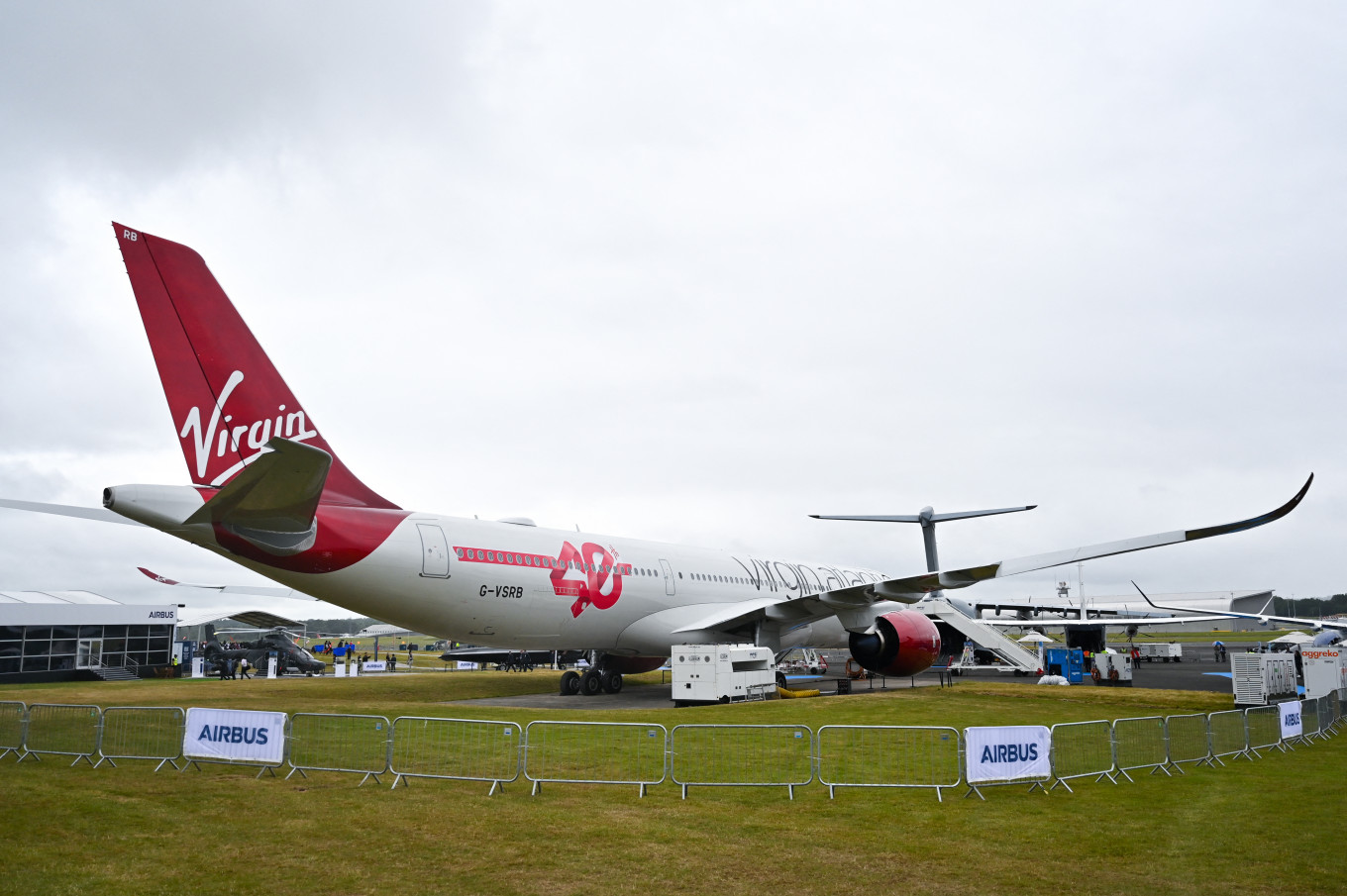Popular Reads
Top Results
Can't find what you're looking for?
View all search resultsPopular Reads
Top Results
Can't find what you're looking for?
View all search resultsLong-haul jets land top orders at Farnborough Airshow
Change text size
Gift Premium Articles
to Anyone
 An Airbus A330-900 is displayed on the second day of the Farnborough International Airshow 2024, south west of London, on Tuesday, July 23, 2024. British airline Virgin Atlantic on Tuesday ordered seven long-haul Airbus A330s, as the European planemaker sought to catch up with United States rival Boeing on orders won at the Farnborough Airshow. (AFP/Justin Tallis)
An Airbus A330-900 is displayed on the second day of the Farnborough International Airshow 2024, south west of London, on Tuesday, July 23, 2024. British airline Virgin Atlantic on Tuesday ordered seven long-haul Airbus A330s, as the European planemaker sought to catch up with United States rival Boeing on orders won at the Farnborough Airshow. (AFP/Justin Tallis)
A
ircraft orders unveiled at Farnborough Airshow this week focused chiefly on the wide-body market, reflecting the desire of airlines to meet a revival in long-haul demand despite production woes.
Crisis-hit Boeing was leading the traditional Farnborough orders battle against Airbus, even though its European rival attempted to fight back.
Boeing delivered blockbuster news on Tuesday as Qatar Airways had ordered 20 more 777X long-range jets, worth $8.8 billion at catalogue prices.
Big orders from major clients typically win significant discounts.
Both aviation titans, however, face huge production backlogs as they struggle to keep up with rebounding global appetite for travel.
Boeing has meanwhile sought to turn a corner over safety concerns ever since a fuselage panel blew out of a 737 MAX flown by Alaska Airlines in January.
Boost
Airbus was boosted earlier on Tuesday with orders for its A330 and A350 planes, which are capable of carrying more than 300 passengers over 13,000 kilometers.
British airline Virgin Atlantic signed a firm order for seven long-haul Airbus A330-900s, bringing to 19 the total number of A330s ordered by the company founded by British billionaire Richard Branson four decades ago.
The jets, due for delivery from 2027 are worth just over US$2 billion according to the most recent 2018 list prices.
Airbus was also lifted after Japan Airlines (JAL) finalized the purchase of 11 single-aisle A321s and 20 A350-900s, including the replacement for a jet lost in a runway collision at Tokyo's Haneda airport in January.
JAL intends to operate the new A350s, which are due for delivery between 2028 and 2032, on international routes.
The news came after JAL had formalized on Monday the purchase of 10 Boeing 787 Dreamliners.
Swoop
On Monday, Boeing swooped for a bumper deal with Korean Air, inking a firm order for 20 777-9 wide-body jets — which has yet to be certified — and 20 787-10 Dreamliners.
The purchase, including an option for 10 extra 787 aircraft, is worth more than $15 billion at catalogue prices.
"I have full confidence in Boeing," Korean Air chief executive Walter Cho told reporters.
One day later, Qatar Airways revealed its vast order for 20 777X aircraft.
"Keeping an eye on the future, we continue to ensure that all Qatar Airways passengers are only met with the best products and services available in the industry," said CEO Badr Mohammed Al-Meer, in a major vote of confidence for the United States giant.
Airbus and Boeing were also lifted this week by the popularity of single-aisle jets which comprise the core of the air transport market.
Airbus inked an order for three A320s and two A321 XLRs from Bhutanese airline Drukair, while Boeing won an order for two 737 MAX-10s from Luxembourg's Luxair.
The US giant was further emboldened as leasing company Macquarie AirFinance lodged a firm order for 20 737-8s, doubling its existing order book.
Constraints
Aircraft manufacturers' order books are full until the end of the decade for single-aisle jets — and production capacity constraints are delaying deliveries.
The world's airlines are therefore seeking to position themselves to benefit from the demand upturn — and receive enough long-haul jets that they require.
The trend is set to continue in 2024.
In the first six months of this year, 40 percent of aircraft sold by Airbus were wide-bodied jets — comprising 27 A330s and 103 A350s.
That compares with a typical proportion of about 20 percent.
For Boeing, 35 percent of its ordered jets were wide-bodied planes — namely 42 B777s and 13 B787s.
Although long-haul traffic is recovering more slowly than medium-haul traffic, it is nevertheless widely forecast to return to its pre-COVID level this year.
Large markets
With global air traffic predicted to double over the next two decades, airlines are seeking to secure aircraft that consume less fuel — and are therefore more profitable — while emitting less carbon dioxide.
Airbus predicts that global demand for wide-bodied jets will reach 8,900 by 2043, while Boeing puts the figure at more than 9,000.
Although Airbus' new ultra-long-range single-aisle A321 XLR jet could reshape the market, wide-body demand is not going to disappear, according to Darren Hulst, Boeing's vice president of commercial marketing.
"About 25 percent of long-haul seats are still on jets that carry 330 seats or more, which means that we need an efficient replacement for long range, long-haul aircraft.
"These large markets are not going away."










